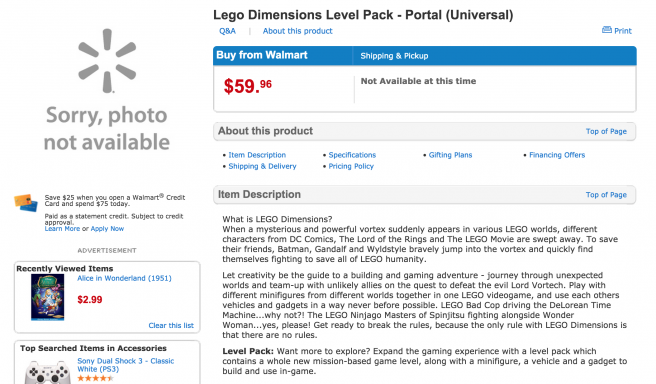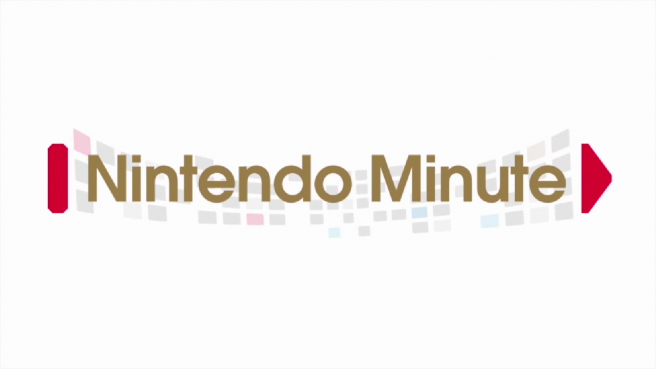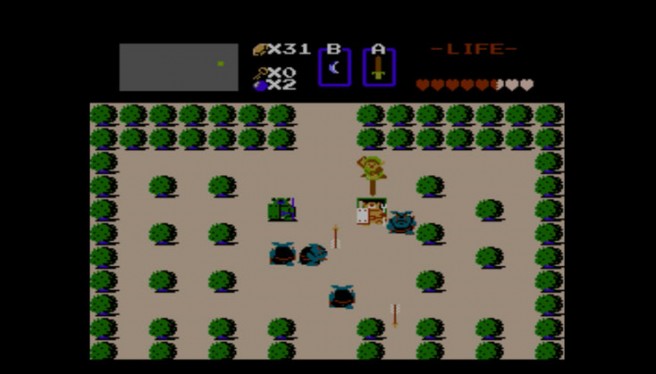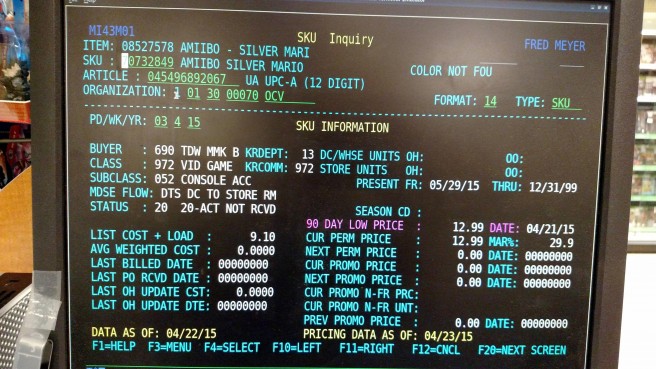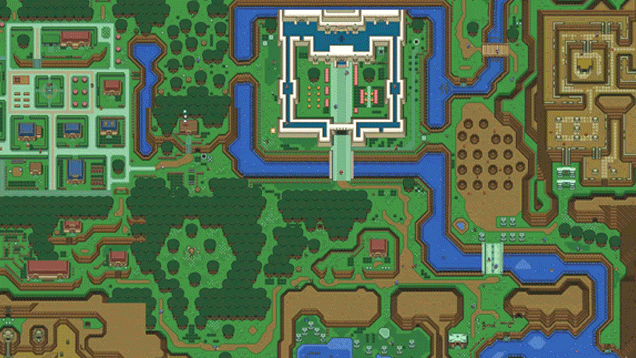Walmart lists new LEGO Dimensions packs – The Simpsons, Portal, and more
Posted on 10 years ago by Brian(@NE_Brian) in General Nintendo, News | 3 Comments
A couple of weeks ago, we heard rumblings about The Simpsons and Portal possibly coming to LEGO Dimensions in some fashion. Listings on Walmart have now made this practically official.
The Simpsons and Portal are being featured in LEGO Dimensions as new Level Packs. Walmart also reveals the existence of Jurassic World and Scooby Doo Team Packs, as well as a few Chima Fun Packs (Cragger, Eris, and Laval).
LEGO Dimensions arrives in late September. Warner Bros. will be making official announcements about the game leading up to launch.
Nintendo Minute – “AMAZ-INK MAY Splatoon Art Contest”
Posted on 10 years ago by Brian(@NE_Brian) in General Nintendo, Videos | 1 Comment
This week’s episode of Nintendo Minute kicks off a month-long focus on Splatoon. The latest video, which features Nintendo’s new art contest, is posted below.
More: Nintendo Minute
Playtonic talks a bit about bringing Yooka-Laylee to Wii U, still interested in amiibo
Posted on 10 years ago by Brian(@NE_Brian) in General Nintendo, News | 3 Comments
Playtonic intends to create 3D platformer Yooka-Laylee for various platforms, including Wii U. One of the reasons this has been made possible is due to the Unity engine (which the game is built on), as it allows for a great deal of flexibility. Playtonic may encounter some issues along the way, but the team is “looking forward” to bringing Yooka-Laylee to Nintendo’s console, and the team’s passionate Wii U technical director should help in getting it up and running.
The studio’s Gavin Price told MCV:
Our engine, Unity, is multi-platform. But we will see what happens when we try switching on all the dev kits we will be receiving in the future. We have still got that hurdle to come across. But we are looking forward to it. We have a very good technical director, and he is a big Wii U fan. So we will be looking for parity across all the platforms if we can. And it would be nice to take advantage of a few platform features or exclusive content.
The possibility of amiibo support is something that Playtonic has mentioned before. It’s something that the company still hopes to pursue, but there’s no news on that front just yet.
With any big company, these discussions don’t happen as fast as us as a team of seven would like. When we want to do something, we can do it tomorrow. But when you are working with partners, we have to work with them at their speed. So something in that area is still very much in our plans, and there is nothing that is impossible to overcome, so what we do with that we will reveal at the right time. But we know what our own expectations are, because we are fans of this stuff ourselves, so we know what is right and what is expected.
More: Amiibo, Gavin Price, interview, Playtonic, Yooka-Laylee
Fan-made amiibo compatibility chart – version 4.1
Posted on 10 years ago by Brian(@NE_Brian) in General Nintendo, Images | 0 comments
Nintendo fan “moldyclay” has once again updated his amiibo chart. All of the latest figures are represented in the graphic, so be sure to take a look at it if you’d like to know which games an amiibo is compatible with!
More: Amiibo
Update: Orders reinstated – Toys “R” Us cancelling some in-store pre-orders for Greninja amiibo
Posted on 10 years ago by Brian(@NE_Brian) in General Nintendo, News | 4 Comments
Update: Good news! Toys “R” Us is reinstating orders. See the email below.
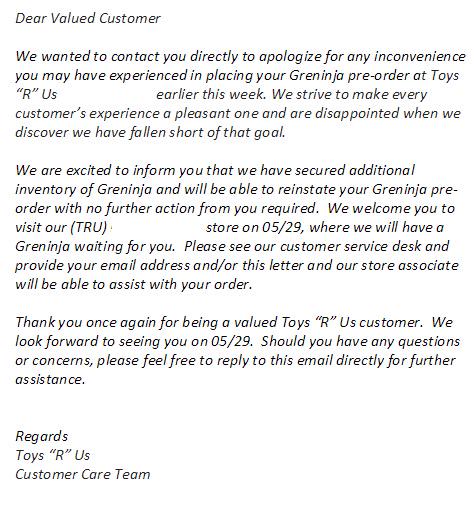
Toys “R” Us opened in-store pre-orders for the Greninja and Pac-Man amiibo yesterday. Greninja was naturally the main attraction here, as it’s exclusive to the retailer. Unfortunately, everything didn’t go as planned. Some consumers started receiving emails from Toys “R” Us today indicating their pre-orders have been cancelled due to a lack of stock.
There’s not much to say other than this is an absolutely awful situation. I can’t imagine getting up early and standing in line, only to have my pre-order randomly cancelled!
Zelda, Super Mario Bros., Pokemon among the finalists for World Video Game Hall of Fame
Posted on 10 years ago by Brian(@NE_Brian) in General Nintendo, News | 25 Comments
The Strong National Museum of Play will be making its first selection for the World Video Game Hall of Fame in June. Nominees have now been announced, and the lineup includes The Legend of Zelda, Super Mario Bros., Pokemon, and more.
The entire listing of finalists is as follows:
Angry Birds
DOOM
FIFA
The Legend of Zelda
Minecraft
The Oregon Trail
Pac-Man
Pokémon
Pong
The Sims
Sonic the Hedgehog
Space Invaders
Super Mario Bros.
Tetris
World of Warcraft
The winner will be chosen based upon its iconic status, longevity, notoriety, and overall impact on the entertainment industry. A committee of journalists and industry bigwigs will be making the decision.
Nikkei suggests Nintendo will post 25 billion yen operating profit for latest fiscal year
Posted on 10 years ago by Brian(@NE_Brian) in General Nintendo, News | 62 Comments
Nintendo’s latest financial results won’t be published until next week, but Japanese outlet Nikkei has shared some rough information about what we can expect.
Nikkei reports that Nintendo is estimated to post an operating profit of 25 billion yen for the fiscal year ending March 2015. The previous forecast was a profit of 20 billion yen. During the same period last year, Nintendo posted a 46.4 billion yen operating loss.
Update: Best Buy rumors – Fred Meyer lists May 29 release date for silver Mario amiibo
Posted on 10 years ago by Brian(@NE_Brian) in General Nintendo, News | 7 Comments
Update 2 (4/29): Adding to the May 29 speculation is a new post on Reddit. Moderators on the amiibo board have been in contact with “A confidential source (at the corporate level)” who said the following:
– Nintendo has provided Best Buy with a UPC (045496892067)
– Best Buy has created a SKU (7352038)
– At this time, there are no plans in place for in-store or online preorders. This may change, but that’s what it’s currently looking like.
– According to their “New Release Calendar” tool, Silver Mario is street dated for May 29
Nintendo still has’t confirmed anything, but these rumors are looking more and more likely.
Update: The silver Mario amiibo SKU is showing up at Target as well with the same date.
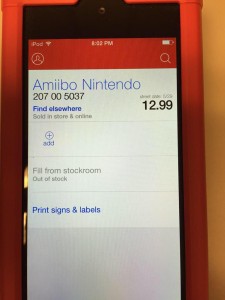
Fred Meyer, a retailer in the United States, is currently listing the silver Mario amiibo for release on May 29. That date hasn’t been confirmed by Nintendo, but this would suggest that it wouldn’t be retailer exclusive unlike gold Mario, which was only sold at Walmart.
The silver Mario amiibo leaked alongside the gold edition back in early February. Nintendo made the gold version official about a week later, though we’ve still been waiting on an announcement for the silver figure.
More: Amiibo
Image & Form on how Rusty’s Runbow collaboration came about, open to seeing the character in a Renegade Kid game
Posted on 10 years ago by Brian(@NE_Brian) in General Nintendo, News, Wii U eShop | 0 comments
Rusty from SteamWorld Dig is appearing in the indie Wii U game Runbow as one of several guest characters. In an interview with Nintendo Okie, Image & Form CEO Brjann Sigurgeirsson explained how Rusty made it into the title.
He said:
Dave Proctor, one of the splendid guys at 13am, simply shot me an email and asked. In the indie community it doesn’t have to be harder than that. That doesn’t mean that we automatically agree to everything. But he sent a gameplay video, and I thought Runbow looked really cool. We then met for beer and Mexican food in San Francisco during GDC and had a wonderful time. I hope Runbow does really well, and that 13am continues to be successful.
Continuing on the topic of collaborations, Sigurgeirsson also said that he’d be open to having Rusty appear in a Renegade Kid title.
As Sigurgeirsson stated:
There’s this very cool guy called Jools Whatsham, who runs Renegade Kid. He’s always been nice and helpful. I wouldn’t mind Rusty appearing in one of their games. We’ll see if that’ll ever happen.
More: Brjann Sigurgeirsson, Image & Form, indie, Runbow
View Zelda: A Link to the Past’s map in your browser
Posted on 10 years ago by Brian(@NE_Brian) in General Nintendo, News, Random | 3 Comments
One fan has gone to the trouble of remaking the map from The Legend of Zelda: A Link to the Past in HTML5. The entire map can be accessed through your browser at this link. It’s definitely impressive – you can even see NPCs and enemies going about their business!
